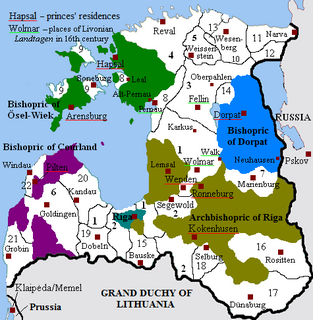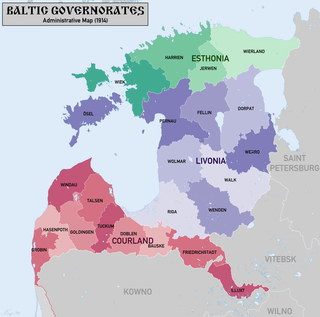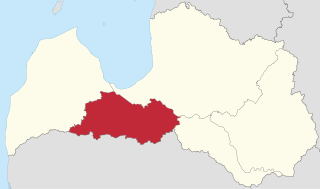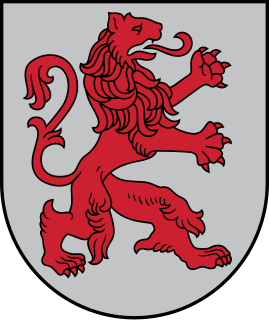
The history of Latvia began around 9000 BC with the end of the last glacial period in northern Europe. Ancient Baltic peoples arrived in the area during the second millennium BC, and four distinct tribal realms in Latvia's territory were identifiable towards the end of the first millennium AD. Latvia's principal river Daugava, was at the head of an important trade route from the Baltic region through Russia into southern Europe and the Middle East that was used by the Vikings and later Nordic and German traders.

Livonia is a historical region on the eastern shores of the Baltic Sea. It is named after the Livonians, who lived on the shores of present-day Latvia.

Baltic Germans were ethnic German inhabitants of the eastern shores of the Baltic Sea, in what today are Estonia and Latvia. Since their coerced resettlement in 1939, Baltic Germans have markedly declined as a geographically determined ethnic group. However, it is estimated that several thousand people with some form of (Baltic) German identity still reside in Latvia and Estonia.

Courland is one of the Historical Latvian Lands in western Latvia. The largest city is Liepāja, the third largest city in Latvia. The regions of Semigallia and Selonia are sometimes considered as part of Courland as they were formerly held by the same duke.

Swedish Livonia was a dominion of the Swedish Empire from 1629 until 1721. The territory, which constituted the southern part of modern Estonia and the northern part of modern Latvia, represented the conquest of the major part of the Polish-Lithuanian Duchy of Livonia during the 1600–1629 Polish-Swedish War. Parts of Livonia and the city of Riga were under Swedish control as early as 1621 and the situation was formalized in the Truce of Altmark 1629, but the whole territory was not ceded formally until the Treaty of Oliva in 1660. The minority part of the Wenden Voivodeship retained by the Polish–Lithuanian Commonwealth was renamed the Inflanty Voivodeship, which today corresponds to the Latgale region of Latvia.

The United Baltic Duchy, or alternatively the "Grand Duchy of Livonia", was the name proposed during World War I by leaders of the local Baltic German nobility for a new monarchical state which, however, never came into existence. The unsuccessful attempt to establish a new German client state on the territory of what is now Latvia and Estonia was made in 1918, during the German occupation of the former Courland, Livonian, and Estonian governorates of the Russian Empire which had ceased to exist after the Bolshevik coup in 1917. The unsuccessful proclamation of a pro-German duchy was first made in April 1918, after the Republic of Estonia had already formally declared full independence from the warring Russian and German Empires.

The Baltic governorates, originally the Ostsee governorates, was a collective name for the administrative units of the Russian Empire set up in the territories of Swedish Estonia, Swedish Livonia (1721) and, afterwards, of the Duchy of Courland and Semigallia (1795).

The Duchy of Livonia, also referred to as Polish Livonia or Livonia was a territory of the Grand Duchy of Lithuania and later the Polish–Lithuanian Commonwealth that existed from 1561 to 1621. It corresponds to the present-day areas of northern Latvia and southern Estonia.

Historical Latvian Lands or formerly Cultural regions of Latvia are several areas within Latvia formally recognised as distinct from the rest of the country. While some of these regions are seen purely as culturally distinct, others have historically been parts of different countries and have been used to divide the country for administrative and other purposes. The Constitution of Latvia recognises four distinct regions: Kurzeme, Zemgale, Latgale and Vidzeme.

Coat of arms of Republic of Latvia was officially adopted by the Constitutional Assembly of Latvia on 15 June 1921, and was in official use from 19 August 1921. It was created using new national symbols and elements of coats of arms of Polish and Swedish Livonia and of the Duchy of Courland and Semigallia. Thus the coat of arms combines symbols of Latvian national statehood, as well as symbols of its historical regions. The Latvian national coat of arms was designed by the Latvian artist Rihards Zariņš.

Semigallia, also spelt Semigalia, is one of the Historical Latvian Lands located in the south of the Daugava river and the north of the Saule region of Samogitia. The territory split between Latvia and Lithuania, previously inhabited by the Semigallian Baltic tribe. They are noted for their long resistance (1219–1290) against the German crusaders and Teutonic Knights during the Northern Crusades. Semigallians had close linguistic and cultural ties with Samogitians.

The Governorate of Livonia, also known as the Livonia Governorate, was a Baltic governorate of the Russian Empire, now divided between Latvia and Estonia.

The Courland Governorate, also known as the Province of Courland, Governorate of Kurland and known from 1795 to 1796 as the Viceroyalty of Courland was one of the Baltic governorates of the Russian Empire, that is now part of the Republic of Latvia.

Curonian Kings are a Latvian cultural group, originally lesser vassals and free farmers that lived in seven villages between Goldingen (Kuldīga) and Hasenpoth (Aizpute) in Courland.

The Bishopric of Courland was the second smallest (4500 km2) ecclesiastical state in the Livonian Confederation founded in the aftermath of the Livonian Crusade. During the Livonian War in 1559 the bishopric became a possession of Denmark, and in 1585 sold by Denmark to Poland–Lithuania.

The Livonian crusade refers to the various military Christianisation campaigns in medieval Livonia – in what is now Latvia and Estonia – during the Papal-sanctioned Northern Crusades in the 12–13th century. The Livonian crusade was conducted mostly by the Holy Roman Empire and the Kingdom of Denmark. It ended with the creation of Terra Mariana and the Danish duchy of Estonia. The lands on the eastern shores of the Baltic Sea were one of the last parts of Europe to be Christianised.

Kandava is a town in Tukums Municipality, in the Courland region of Latvia. It had a population of 3,656 people as of January 2020.

Terra Mariana was the official name for Medieval Livonia or Old Livonia. It was formed in the aftermath of the Livonian Crusade, and its territories were composed of present-day Estonia and Latvia. It was established on 2 February 1207, as a principality of the Holy Roman Empire, but lost this status in 1215 when Pope Innocent III proclaimed it as directly subject to the Holy See.

The coat of arms of Courland (Kurzeme), a historical region in western Latvia, has been known since the 16th century and depicts a lion gules on a silver background.
Anarchism in Latvia emerged from the Latvian National Awakening and saw its apex during the 1905 Russian Revolution. Eventually the Latvian anarchist movement was suppressed by a series of authoritarian regimes in the country.
















